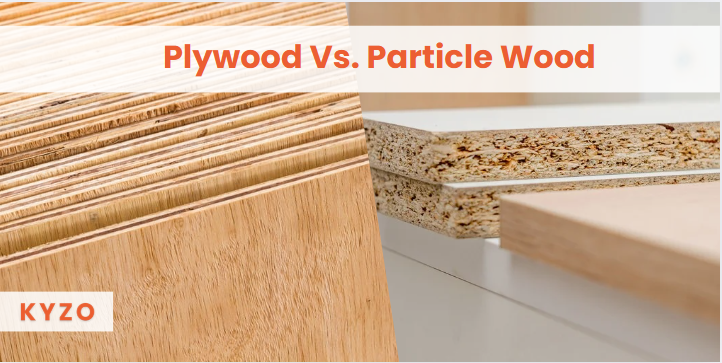
Plywood vs Particle Board: Which is Better for Furniture?
Share
When one talks about making-specific furniture, it refers to the choice of materials themselves and the bodies of designs. Plywood and particle boards are perhaps the most general examples of engineered wood, each having its own set of effects and drawbacks. Cost and durability, look, and being eco-friendly; each has something to them. Learn in this blog how plywood differs from particle board as you make an informed choice for your furniture-making efforts.

Why Material Matters in Custom Furniture
Whether you're designing a modular kitchen, wardrobe, or TV unit, the material underneath the finish impacts everything—durability, cost, longevity, and even aesthetics.
- Plywood is strong, resistant, and better suited for bearing furniture.
- Particle board is effective and smoother to finish, ideal for load applications or aesthetic furniture pieces.
When customizing furniture, using the right core material ensures that it not only looks good on the outside but also stands the test of time.
You can also explore Khidki Ply Products here
At a Glance: Plywood vs Particle Board
Here’s a quick comparison of key attributes:
| Feature | Plywood | Particle Board |
| Composition | Cross-laminated wood veneers | Compressed wood chips and sawdust |
| Strength & Load Capacity | High | Moderate to Low |
| Moisture Resistance | Better with BWR/BWP grades | Poor – swells with water |
| Finish Compatibility | Good, requires minor prep | Excellent – smoother surface |
| Cost | Higher | Budget-friendly |
| Weight | Lighter | Heavier |
| Durability | Long-lasting | Short to moderate lifespan |
| Eco-friendliness | Depends on adhesive used | Often made from recycled wood |
What Wood Are Plywood and Particleboard Made From?
Plywood is manufactured by placing thin wood layers and cross-laminating them in a very tough and durable manner for its use or application. Consequently, plywood is available in so many different grades making it applicable for MR-Moisture Resistant, BWR - Boiling Water Resistant, and BWP-Boiling Waterproof among others. On the other hand, Wood particle board can best be defined as a mass compressed densely which has been pressed wood chips, sawdust, and resin put together at very high pressure. The surface density and smoothness as compared to many other wood products make this more useful for laminated and laminated boards.
Key Differences in Composition and Surface
Natural grain exists in plywood, and the layers make it more resistant to any form of warping or even cracking. In addition, the surface is slightly rougher, making it better with screws.
Particle Board, on the other hand, has a completely uniform surface with no grain. It is much smoother and better suited to high-gloss or matte laminates but has the disadvantage of not being able to take screws and nails very well because of its softer core.
You can also read about Benefits of Waterproof Plywood here
Maintenance & Durability

- Plywood The plywood is known for its strength, resistance to moisture, and wear and tear. It does not sag even under weight; it can also be used in humid areas like kitchens and bathrooms (especially in BWR/BWP grade).
- Particle Board If particle board gets wet, it will swell. It is best for dry places and furniture that does not get heavy use-such as bookshelves, dressing tables, or decorative cabinets.
In terms of maintenance, both are easy to clean, but plywood wins in longevity.
Cost and Environmental Impact
Cost is one of the major deciding factors
- Plywood is more expensive, especially in waterproof or marine grades.
- Particle board is more affordable, which makes it popular in mass-produced furniture and budget modular fittings.

Eco-friendliness varies:
- Particle board often uses recycled wood waste, making it a greener option.
- Plywood can be eco-friendly too, but check if it’s E1/E0 certified for low formaldehyde emissions.
You can also read about types of plywood here
Where to Use Plywood vs Particle Board?
Here’s how you can use both smartly based on application:
- Plywood is best for:
- Particle board works well for:
Using a hybrid approach—plywood for the structure and particle board for shelves or shutters—can help balance cost and strength.
You can also look for beautiful Plywood Pooja Mandir Designs here
Pros and Cons of Both Materials
Plywood – Pros
- Strong and durable
- Moisture-resistant (BWR/BWP)
- Holds screws well
- Long-lasting performance
Plywood – Cons
- More expensive
- Slightly uneven surface (requires extra prep for laminate)
- Heavier in marine-grade options
Particle Board – Pros
- Affordable
- Smooth surface for laminate or pre-lam designs
- Lightweight
- Eco-friendly (often made from recycled material)
Particle Board – Cons
- Low resistance to moisture
- Not suitable for heavy loads
- Shorter lifespan
- Prone to sagging or chipping with screws
Conclusion
Plywood is typically far more robust than particleboard in contrast, and the latter is cheaper. On these facts, make your selection depending on the consideration of your budget and its application and strength requirement. However, if you are making furniture with permanence and wear-and-tear in mind, the best investment is plywood. For the bargain-hunter, however, if finish is more critical than load-bearing strength, particleboard will fit the criteria for smart purchase.

Knowing how to differentiate plywood from particle board is vital in selecting what materials go where on furniture. This saves the aesthetics of the furniture design while ensuring that it would still function over time.
Want to know the difference between Engineered Wood Vs. Plywood read here.
FAQs
Q1. Is plywood stronger than particle board?
Ans. Yes, plywood is significantly stronger due to its cross-layered veneer construction, making it ideal for load-bearing furniture.
Q2. Which is more affordable: plywood or particle board?
Ans. Particle board is more affordable, making it a popular choice for budget furniture and modular setups.
Q3. Can particle boards be used for heavy furniture?
Ans. No, a particle board isn’t suitable for heavy loads. It’s best used for light-duty furniture like bookshelves, TV units, or decorative pieces.
Q4. Which is easier to maintain?
Ans. Both are low-maintenance, but plywood is more durable and moisture-resistant, requiring less upkeep over time.
Q5. Is particle board eco-friendly?
Ans. Yes, particle board is often made from recycled wood waste, making it an environmentally friendly option.























